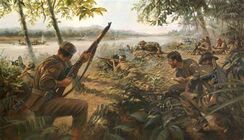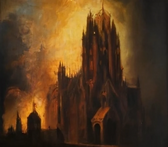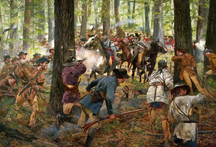The Vrignyan Revolution (Pacifica)
The Vrignyan Revolution (Vrignyan: Vrigxed Vikexir) or Vrignyan Revolutionary War (Vrignyan: Vrigxed Vikexiren Karvrak) was a period of sudden political and societal change in Vrigny which occurred mainly as a 11 year long civil war. Although several changes and smaller uprisings were reported prior, the date which is regarded as the official start of the Revolution is March 31 1801, due to the large scale of the Adlan Uprising and the skirmishes that followed. Due to the poor economic and societal conditions of the Vrignyan society under the rule of Zarnarch Erick Hassarn, the Revolution gained substantial support by the Vrignyan peasantry and parts of the military.
The initial conflict is considered to have ended on November 11 1806, after the end of the revolutionary conquest of the city of Vraks, the historical, administrative and spiritual capital of the Zarnarchy. Immediately after the revolutionary victory in the city, Zarnarch Erick Hassarn and Allxervar Jagan Yurin were captured trying to flee south to the remainder of Zarkanxiz-controlled territories. On the same day, both leaders were executed by a wooden stake against their heart and beheading. With the deaths of the Zarnarch and highest authority of the Zarkanxiz religion, the First Republic of Vrigny was proclaimed.
These executions sparked a war with the Marzarchy of Firest, a semi-independent vassal theocracy of the Zarnarchy. This war ended after 3 years of conflict between the remaining Zarkanxiz loyalist troops, the Firestian proper military and the Republican Army. With the Marzarchy of Firest defeated, the Vrignyan Republic of Firest was proclaimed as a fully independent Republic.
The Vrignyan Revolution officially ended on May 28 1812 after the final surrender of the southeastern Zarkanxiz guerrillas.
Causes
The Revolution was the result of several long-term and short-term factors that ended in a social, economic, financial and political crisis in the late 1790s and early 1800s. Due to the adoption of several authoritarian reforms by the Zarkanxiz clergy and administration, suggested mainly by Allxervar Jagan Yurin, Zarnarch Erick Hassarn and both their predecessors, the state was unable to gather enough support to uphold their values and manage the crisis.
Between 1730 and 1801, the Vrignyan population grew from an estimation of 18 to 26 million. The proportion of population living in the main towns and cities increased, with the three largest cities: Vraks, Adlan and Lifov having a population of around 450,000 each. Although the 18th century was relatively prosperous, the benefits were distributed mainly throughout the Vrignyan clergy and upper classes, as well as to maintain the Vrignyan colonization effort in Firestian lands. This unequal distribution due to the legislation of extraordinary taxes on the peasantry led to an increase of social conflict, which was exacerbated by the start of an economic recession since 1790. This recession led to high unemployment, and due to bad harvests and the tax on pastures for religious sacrifices, food prices also rose. This economic situation caused several small uprisings all around the Zarnarchy and only worsened the crisis.



